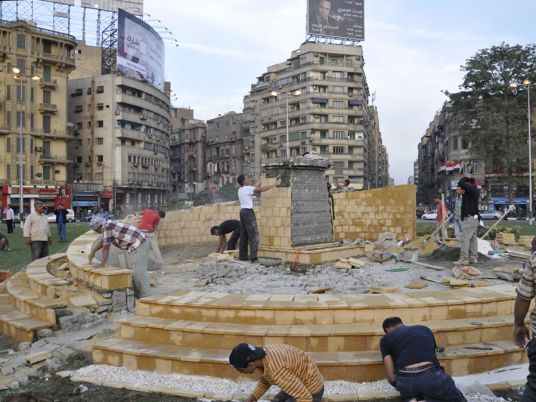
In the Al-Ahram newspaper issue of 3 March 1975, the critic Makram Hanin wrote the following about the artist Sami Rafe who designed the Tomb of the Unknown Soldier:
“It is a simple yet inspirational idea.”
Rafe, 44 years old at that time, was an assistant professor of decoration at the Faculty of Fine Arts in Cairo.
His concrete and pyramid-shaped memorial combines greatness, simplicity, sacrifice and immortality.
On the first anniversary of the October War, President Sadat ordered the construction of a monument that includes the remains of a war martyr to commemorate the unknown soldier.
Sami Rafe, who then had a doctorate from the Faculty of Fine Arts in Vienna, won the bid to design the monument. He began working on it on 25 May 1975 and finished it on 15 September of the same year. It consists of four opposite walls that meet at the top to form a pyramid, the epitome of the ancient Egyptian belief in immortality.
The hollow pyramid is 33.64 meters high, the base is 14.30 meters wide and the thickness of the walls at the bottom is 1.9 meters. Inscribed on them are 71 names in Kufic characters on basalt stone. They represent anonymous heroes for whom he chose symbolic names that are common among Egyptians.
On 6 October 1975, President Anwar Sadat and Vice President Hosni Mubarak inaugurated the memorial and placed a wreath on the Tomb of the Unknown Soldier.
And in October 1981, Sadat was buried at the site of the memorial next to the tomb.
The jury in charge of selecting the best design for the memorial chose Rafe’s because it combined simplicity and depth and because it stemmed from the Egyptian identity at the same time. Among the jury was the renowned artist Bikar who wrote an article about the memorial titled ‘A Lesson in Rhetoric’ in which he said:
“I had the honor to be a member of the committee that was tasked with the October War memorial project and a member of the jury that chose the winning design from 75 different designs presented by architects and sculptors. It was amazing that Sami Rafe won the first prize although he is a decorist and not a sculptor.”
Other works by Rafe include the frescoes of 19 stations of the second subway line for a total area of 3250 square meters, the base of the Ramses obelisk in front of Cairo International Airport in 2002 and the stage decoration of the opera Aida in Al-Gomhouria Theater in 1984.
He won several awards, including the first prize for the UNESCO Peace Declaration in 1962.
His works address the masses directly.
Rafe was born in Cairo on 8 April 1931. He was a board member of the Cairo Atelier, a member of the Fine Arts Syndicate, a professor at the Faculty of Fine Arts in Cairo and a chairman of the decoration department of the Helwan University Faculty of Fine Arts.
He had several exclusive and collective exhibitions since 1955 in Egypt and abroad, including Arab countries, Russia, Poland, Austria, France, Romania, Germany and Spain.
Edited translation from Al-Masry Al-Youm



